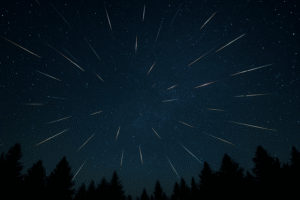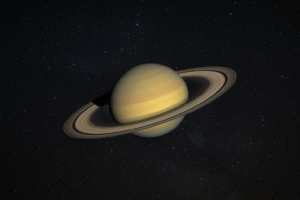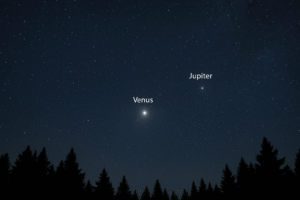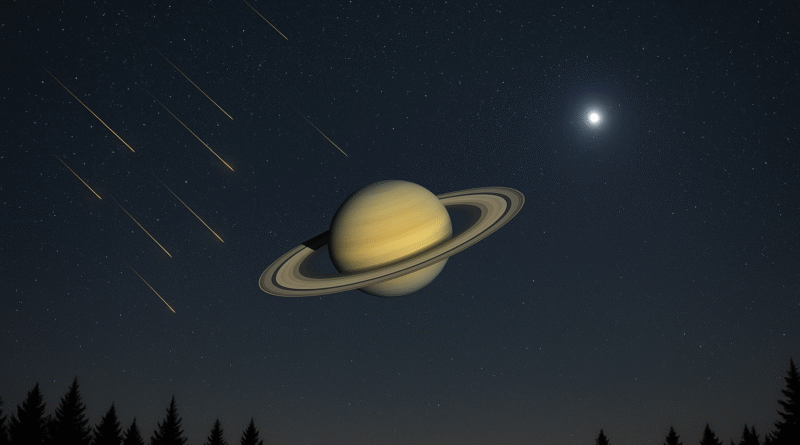Don’t Miss These Stunning Space Events in September 2025
Space events in September 2025 will amaze sky-watchers with stunning sights. From Saturn’s bright opposition to the Full Corn Moon and subtle meteor showers, the night sky will be full of wonders visible from the United States.
Space Events in September 2025: Meteor Showers to Watch

Credit: AI-generated image by ChatGPT.
September has no major meteor shower like the Perseids, but two subtle showers become active late in the month:
- Southern Taurids: Active late Sept–Nov (radiant near Taurus). These meteors are slow and often bright; you might see a few per hour (especially around early Oct).
- Orionids: Begin around Sept. 26 and peak Oct. 20. By late September, Orion rises before dawn – you may catch a stray Orionid or two after midnight.
Any moonlight can drown out faint meteors, so the best time to look is after dark on moonless nights. Try watching after midnight as Orion climbs, and find a dark rural sky away from city lights.
Major Space Events in September 2025: Planetary Highlights
:contentReference[oaicite:2]{index=2} Saturn rising in the east at sunset around Sept. 21, 2025. Image: NASA/Hubble (color added) Saturn is the big draw in September 2025. The gas giant reaches opposition on Sept. 21 (when Earth passes between Saturn and the Sun). EarthSky notes that Saturn will rise at sunset on Sept. 21 and stay visible all night:contentReference[oaicite:3]{index=3}. At that time Saturn shines at magnitude ~0.6 (its brightest of the year), appearing as a steady yellowish dot.
Saturn at Opposition (Sept. 21)

Credit: AI-generated image by ChatGPT.
At opposition, Saturn will be at its closest approach in 2025. It appears as a bright dot all night long. Saturn’s rings will be tilted only about 2° from our view, so even a small telescope will see them as a very thin line.
Venus, Jupiter and Regulus (Sept. 19)

Credit: AI-generated image by ChatGPT.
Crescent Moon in early dawn, similar to what you’ll see around Sept. 19, 2025. Image: Andrea Ferrario via Unsplash EarthSky notes that about 90 minutes before sunrise on Sept. 19, a thin crescent Moon will lie close to bright Venus, with the star Regulus just to their side. Venus (the brilliant Morning Star) will be easy to spot nearby. Jupiter will shine as a very bright “star” in late September. Mars, by contrast, will be much fainter and appear low in the west at dusk. (Mercury remains too close to the Sun to see.)
Moon Phases and Other Space Events in September 2025
The Moon’s phases add classic events to September’s skies. The full moon occurs on Sept. 7 at about 2:09 PM EDT. This full Moon is called the Corn Moon (since it often coincides with the corn harvest). On the evening of Sept. 7, the Moon will rise around sunset, glowing orange in the east. (There is also a total lunar eclipse that night, but NASA Science confirms it will be visible only from Europe, Asia, Africa, and Australia.)
- Sept. 7 – Full Corn Moon: Moon opposite the Sun, rising at sunset. Harvest-time moonlight will light the night.
- Sept. 21 – New Moon: Moon and Sun together. The sky will be moonless, giving dark conditions ideal for stargazing.
There is also a partial solar eclipse on Sept. 21, but it’s only visible from New Zealand and Antarctica. American sky-watchers in September will see just the regular Full Corn Moon (Sept. 7) and the subsequent New Moon (Sept. 21) with no local eclipse.
Equinox and Sky-Watching Tips
The September equinox occurs on Sept. 22, 2025 (start of fall). After this date, our nights start getting longer. Around the equinox, the zodiacal light – a faint cone of sunlight along the ecliptic – is most visible. With the new Moon on Sept. 21, the sky will be moonless and ideal for viewing faint objects or meteors.
For observing, choose dark, clear nights after the New Moon (late September). Use any star chart or app to locate Saturn (in Pisces/Aquarius), Jupiter (in Gemini/Taurus), and the bright stars mentioned above. Dress warmly, be patient, and enjoy the clear, crisp nights of early fall.
Conclusion
September 2025 will be a busy month for sky enthusiasts. Saturn shines all night at its best, a crescent Moon meets Venus and Regulus before dawn, and early Orionid and Taurid meteors may flicker across the sky. The changing seasons bring new constellations, and the dark nights around New Moon (Sept. 21) make it perfect to head outside. Grab a warm jacket, find a dark horizon, and enjoy the mysterious beauty of the September sky. This month’s sky requires no telescope – just your eyes and a clear sky. From backyard gazing to family stargazing nights, enjoy the celestial show.
FAQs
Q: Are there any meteor showers in September that I can see?
A: The major meteor showers are mostly over by early September, but two minor showers are active late in the month. The Southern Taurids run Sept. 20–Nov. 20 (peak Oct. 9–10), and the Orionids begin around Sept. 26. With dark skies, you might spot a few Taurids or early Orionids after midnight.
Q: When is the full moon in September 2025, and why is it called the Corn Moon?
A: The full moon peaks on Sept. 7, 2025. It’s called the “Corn Moon” because it coincides with the corn harvest season. After Sept. 7, the next new moon on Sept. 21 will give especially dark nights for stargazing.
Did you enjoy exploring the sky events for September 2025? Leave a comment below to share your stargazing plans or ask any questions. We’d love to hear from you!

